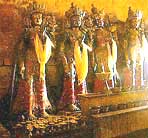

 |  |
|
|
|
.....Continue
 The establishment dates back to the 17th century but has been much rebuilt. It consists of more than 60 buildings, with prayer halls, meeting halls and a library of large proportions. The principal shrine is an imposing stone sculptures in which painted thangkas, bronze images of the deities of the Mahayana pantheon and a richly gilded seated Buddha, no less than 8m (26 ft) high, are displayed. Of importance in the annual life of the monastery is the New Year's festival with its mask dances.
Tawang Monastery The establishment dates back to the 17th century but has been much rebuilt. It consists of more than 60 buildings, with prayer halls, meeting halls and a library of large proportions. The principal shrine is an imposing stone sculptures in which painted thangkas, bronze images of the deities of the Mahayana pantheon and a richly gilded seated Buddha, no less than 8m (26 ft) high, are displayed. Of importance in the annual life of the monastery is the New Year's festival with its mask dances.
Udaipur
|
Copyright ©2000 indiansaga.info. All rights reserved.
By using this service, you accept that you won't copy or use the data given in this website for any commercial purpose.
The material on indiansaga.info is for informational & educational purpose only.
This site is best viewed at 800 X 600 picture resolution.